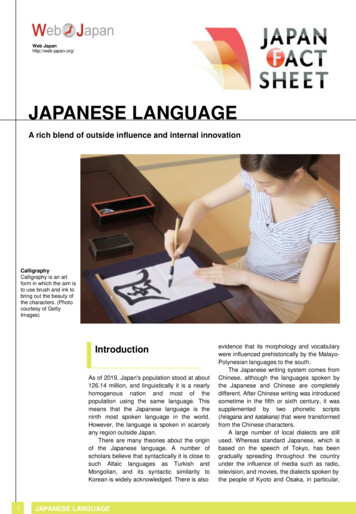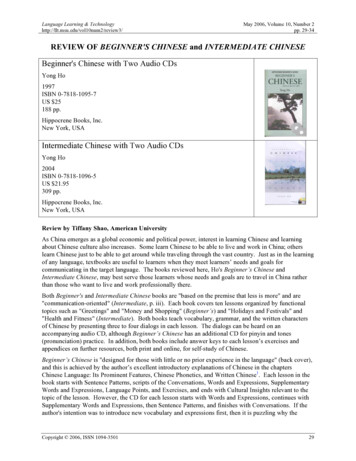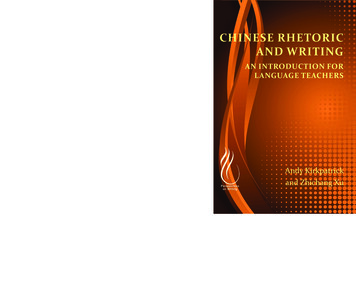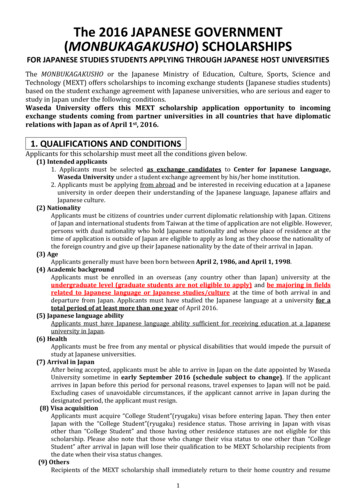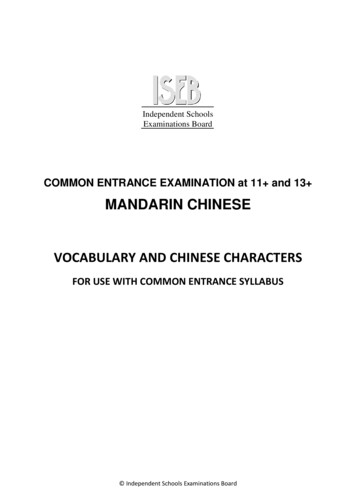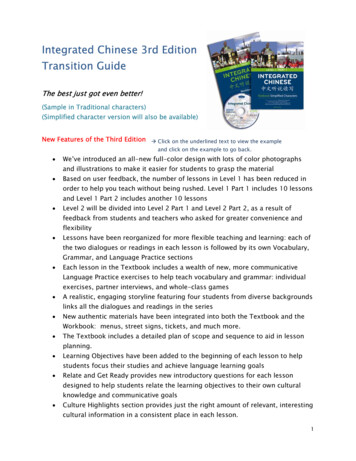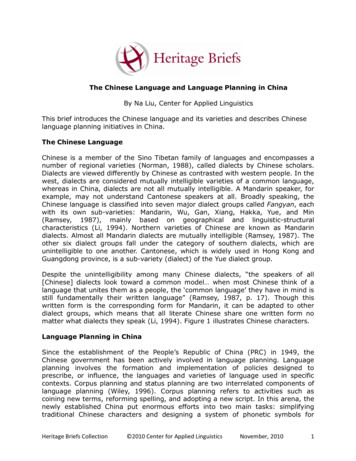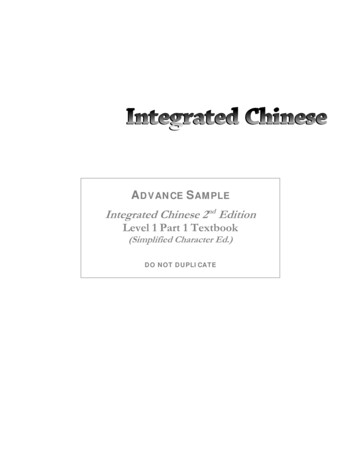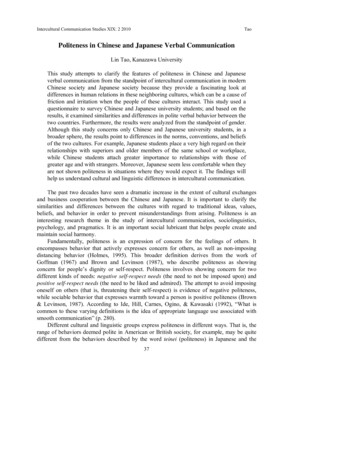
Transcription
Intercultural Communication Studies XIX: 2 2010TaoPoliteness in Chinese and Japanese Verbal CommunicationLin Tao, Kanazawa UniversityThis study attempts to clarify the features of politeness in Chinese and Japaneseverbal communication from the standpoint of intercultural communication in modernChinese society and Japanese society because they provide a fascinating look atdifferences in human relations in these neighboring cultures, which can be a cause offriction and irritation when the people of these cultures interact. This study used aquestionnaire to survey Chinese and Japanese university students; and based on theresults, it examined similarities and differences in polite verbal behavior between thetwo countries. Furthermore, the results were analyzed from the standpoint of gender.Although this study concerns only Chinese and Japanese university students, in abroader sphere, the results point to differences in the norms, conventions, and beliefsof the two cultures. For example, Japanese students place a very high regard on theirrelationships with superiors and older members of the same school or workplace,while Chinese students attach greater importance to relationships with those ofgreater age and with strangers. Moreover, Japanese seem less comfortable when theyare not shown politeness in situations where they would expect it. The findings willhelp us understand cultural and linguistic differences in intercultural communication.The past two decades have seen a dramatic increase in the extent of cultural exchangesand business cooperation between the Chinese and Japanese. It is important to clarify thesimilarities and differences between the cultures with regard to traditional ideas, values,beliefs, and behavior in order to prevent misunderstandings from arising. Politeness is aninteresting research theme in the study of intercultural communication, sociolinguistics,psychology, and pragmatics. It is an important social lubricant that helps people create andmaintain social harmony.Fundamentally, politeness is an expression of concern for the feelings of others. Itencompasses behavior that actively expresses concern for others, as well as non-imposingdistancing behavior (Holmes, 1995). This broader definition derives from the work ofGoffman (1967) and Brown and Levinson (1987), who describe politeness as showingconcern for people’s dignity or self-respect. Politeness involves showing concern for twodifferent kinds of needs: negative self-respect needs (the need to not be imposed upon) andpositive self-respect needs (the need to be liked and admired). The attempt to avoid imposingoneself on others (that is, threatening their self-respect) is evidence of negative politeness,while sociable behavior that expresses warmth toward a person is positive politeness (Brown& Levinson, 1987). According to Ide, Hill, Carnes, Ogino, & Kawasaki (1992), “What iscommon to these varying definitions is the idea of appropriate language use associated withsmooth communication” (p. 280).Different cultural and linguistic groups express politeness in different ways. That is, therange of behaviors deemed polite in American or British society, for example, may be quitedifferent from the behaviors described by the word teinei (politeness) in Japanese and the37
Intercultural Communication Studies XIX: 2 2010Taoexpression you limao (有礼貌) in Chinese. Linguistic politeness, then, reflects culturalvalues. Correctly identifying polite behavior in a culture involves understanding the society’svalues (Holmes, 1995). Up to now, most characterizations of interactive social behavior havebeen conceptualized in terms of politeness. However, what is considered polite in Americanor British culture represents only some of the components of politeness. For example,Hoflichkeit (politeness) in German (Held, 1992) or teinei (politeness) in Japanese.To get a more comprehensive understanding of the aspects involved, Hermanns (1993)uses a higher-order notion called concepts of communicative virtues. These are concepts thathave been developed over a long period of time and undergo continual transformation inongoing social interactions; they are concepts to which members of a society refer inevaluating the social behavior of others as well as themselves (Marui, Nishijima, Noro,Reinelt, & Yamashita, 1996). Many researchers are now studying this subject. For example,Hermanns (1993) and Yamashita (1993) have researched the evaluating concepts forcommunicative behavior in German, and Nishijima (1995, 2007) has done the same forJapanese. Ide, Hill, Carnes, Ogino, and Kawasaki (1992) wrote about the concept ofpoliteness in an empirical study of American English and Japanese. Many researchers(Kuhlmann, 2005; Nam, Nishijima, & Saiki, 2006; Nishijima, 2007; Nishijima & Tao, 2009;Marui, Nishijima, Noro, Reinelt, & Yamashita, 1996; Tao, 2008, among others) have donecomparative research in this field.However, there has been little contrastive research on the evaluating concepts in Japaneseand Chinese, even though these two peoples are closely related both geographically andculturally. There has also been little study on a number of important questions: how youngpeople use politeness, how young people feel about politeness, the types of people to whomyoung people tend to be polite, and gender differences in the frequency of use of politeness.To elucidate the differences between the two cultures, a study employing a 28-questionquestionnaire was carried out on basic features of evaluating concepts for communicationbehavior. This paper reports some of the findings.Research in this field is needed to break down communication barriers between Chineseand Japanese when they come into daily contact. Although politeness may be expressed bothverbally and non-verbally, this study focused on polite verbal communication or, in otherwords, on the use of words to express politeness. It employed an opinion poll taken byChinese and Japanese university students to collect data for a comparative study of politenessin Chinese and Japanese verbal communication. Based on the results, the similarities anddifferences between polite Chinese and Japanese verbal communication are examined. Thisstudy also provides insights into the traditional moral values on which polite behavior isbased in both countries and also analyzes the results from the standpoint of gender. Thespecific purpose of this study was to answer five research questions.PolitenessPoliteness has been a major concern in pragmatics since the late 1970s. Brown andLevinson’s politeness theory, first published in 1978, generated a wealth of conceptual andempirical research, undertaken in the theoretical and methodological traditions of a number of38
Intercultural Communication Studies XIX: 2 2010Taosocial sciences, such as anthropology, developmental psychology and psycholinguistics,linguistics, sociolinguistics, pragmatics, applied linguistics, and communication.Kasper (1990) summarized the work of Lakoff (1973, 1975), Brown and Levinson (1978,1987), and Leech (1983) as follows: Politeness is viewed as a rational, rule-governed,pragmatic aspect of speech that is rooted in the human need to maintain relationships andavoid conflicts. Polite speakers are assumed to modulate (mainly dilute, tone down) thespecificity, assertiveness, value-ladenness, and so forth, of their utterances (Held, 1989), tosignal respect for, and/or acceptance of, each others’ feelings, needs, and desires. By beingmutually supportive and avoiding threats to face, according to the standard argument,speakers maintain smooth relations and sustain successful communication. The underlyingrational, motivation, and functional foundations of politeness are assumed to be, to someextent, universal, and are assumed to influence, and be reflected in, various modes of speechin many different languages and cultures (Brown & Levinson, 1987).However, Brown and Levinson’s theory of the universals of linguistic politeness—themain theory-problem-method-apparatus-framework in cross-cultural studies—has beenincreasingly criticized for its strong orientation toward British analytical logic and NorthAmerican social psychology (Held, 1989; Ide, 1989). In many non-Western cultures, theunderlying focus of interaction is centered not on the individual, but on the group (Ide, 1989;Matsumoto, 1988, 1989); their politeness behavior departs considerably from the assumptionsof Western social psychology about agnostic relationships between speakers and speechstrategies (Held, 1989). By putting Brown and Levinson’s politeness theory in the context ofthe ongoing debate between universalists and relativists in the Western linguistic tradition,Jenney and Arndt (1993) suggest that, like other theories of universal language, Brown andLevinson’s theory lacks a culturally unbiased conceptual framework for objectively andempirically evaluating their politeness universals. They propose a methodological shift awayfrom investigating universals of politeness to studying cultural identity in its various linguisticand other manifestations, a shift that helps to account for cultural variations in politeness froma more flexible point of view.The phenomenon of linguistic politeness exists in almost all cultures and languages.Politeness is an important method of making communication smooth. It is the common desireof most human beings to respect others, make friends, and speak politely; but polite languageand its use are indeed different in different cultures, and cultural variations in politeness aregenerally related to notions of linguistic and cultural relativity.Politeness in ChineseThere is a growing awareness that the term politeness needs to be defined more preciselyand consistently if more fruitful cross-cultural research on politeness is to be pursed (Watts,Ide, & Ehlich, 1992). Mao (1992) stated the relationship between Chinese face and politeness(limao):More specifically, to be polite, that is, you Limao (有礼貌) in Chinese discourse is,in many respects, to know how to attend to each other’s mianzi and lian and to enact39
Intercultural Communication Studies XIX: 2 2010Taospeech acts appropriate to and worthy of such an image. Otherwise stated, mainlandChinese speakers can be seen as being polite if they demonstrate with words theirknowledge of mianzi and lian, such a demonstration tends to epitomize politeness inthe eyes of their discourse partners.” (p. 85)The closest Chinese equivalent to the English word politeness is Limao. Gu (1990)investigated Limao and pointed out that the word Limao is derived from the old Chineseword, Li (礼). He reviewed the classical notion of Li formulated by Confucius (551-479B.C.), whose influence remains strong to this day. Li does not mean politeness; it refers to thesocial hierarchy and order of the slavery system of the Zhou Dynasty (dating back to 1100B.C.), which Confucius regarded as an ideal model for any society. It held an important placein the philosophical thought of old China. Not until two or three hundred years afterConfucius did Li become established as a word meaning politeness. This usage is found in thebook, Li Ji (礼記 On Li), compiled (reputedly) by Dai Sheng sometime during the East HanDynasty. The volume opens with: “Deference cannot not be shown by others as well as theself,” “Speaking of Li (i.e., politeness), humble yourself but show respect to others.”Denigrating self and respecting others remain at the core of the modern concept of Limao (ascited in Gu, 1990, p. 238).Since the founding of the People’s Republic of China in 1949, a new social structure hasarisen with new social relationships. This certainly has had some effect on politeness and itsrole in people’s lives. Gu (1990) pointed out that there are basically four notions underlyingthe Chinese conception of Limao: (a) respectfulness, (b) modesty, (c) attitudinal warmth, and(d) refinement. Respectfulness is self’s positive appreciation or admiration of othersconcerning the latter face, social status, and so on. Modesty can be seen as another way ofsaying self-denigration. Attitudinal warmth is consideration, and hospitality to other. Finally,refinement refers to self’s behavior to other which meets certain standards. In the last threedecades or so, the “Beautification of Speech” campaign has tried to revive the four elements,which are part of Chinese heritage, and has explicitly appealed to the nation to abide by them.Deference is an important element of modern 礼貌 (Limao, politeness). Its social function isto maintain harmony, eliminate conflict, and promote cooperation between people.I quite agree with Mao’s argument (1992) that “to understand Chinese politeness, it isnecessary to study face (mianzi and lian)” (p. 83). Chinese face includes mianzi and lian.Mainzi pursues public acknowledgment of one’s prestige or reputation. That is to say,Chinese face emphasizes not individual want or desires but the harmony of individual actionwith social norms and the community judgments of action. Chinese politeness (limao) makesmuch of the ethics of courtesy and uses li to treat the people and things. That is, being politein Chinese discourse makes a good impression on the person one is speaking to and on thosenearby; and it will increase one’s reputation (lian and mianzi) in society because politebehavior is praised by society. Thus, one earns a good reputation, thereby increasing one’sself-respect.40
Intercultural Communication Studies XIX: 2 2010TaoPoliteness in JapaneseAccording to Haugh (2007), the emic notion of politeness in Japanese can be approached,in the first instance, from the perspective of two key lexemes: teinei and reigi (tadashii).Language usage plays a large role in Japanese politeness. The use of keigo (honorific forms)is a major strategy in demonstrating politeness in Japan (Ogawa & Gudykunst, 1999-2000).Japanese scholars speculate that it developed from terms used to praise God, terms used toavoid taboos, and other types of expressions. The use of beautiful language toward God wasthought to bring happiness to people through the magical power of language, thus functioningas a positive strategy. Honorific forms also originated from expressions referring tosomething or someone high in status. As these expressions were used repeatedly over time,they became conventional grammatical forms and fossilized into a system of honorific forms.Akasu and Asao (1993) explain that “keigo typically is used to show deference to thelistener, to some third party, or to some referent related to him/her. That means that theperson to whom the keigo is directed must be someone worthy in some way of thatdeference” (p. 98). The more recent conceptualization of politeness in Japanese shifts thefocus away from a concern for social position (mibun) or status (chi’i) to potentially lesshierarchical dimensions, such as the dignity and character of others (jinkaku).Several Japanese philosophers developed a philosophy of moral standards intended tomake it possible for the Japanese to live together peacefully. This philosophy has beenhanded down to modern times. It sets the moral standards for how people should behaveaccording to their designated roles in society. According to Hill, Ide, Ikuta, Kawasaki, andOgino (1986), one of the key terms used by Oguu Sorai, one of the founders of thisphilosophy, is wakimae. This philosophy forms one of the major habitual thought patterns ofcontemporary Japanese culture. In Japanese, it is crucial for a speaker to perceive the socialcontext, such as the kind of situation or setting, he or she is in. It is also called discernment;that is, in contact between Japanese people, the speaker should pay attention to addressingcertain factors of the situation, and then select an appropriate linguistic form and appropriatebehavior.The reason why Japanese tend to be formal and wakimae in non-intimate ingroups andoutgroups, and informal in intimate ingroups can be explained by amae (dependence) (Ogawa& Gudykunst, 1999-2000). Amae is “the noun form of amaeru, an intransitive verb whichmeans ‘to depend and presume upon another’s benevolence’ . . . . [It involves] helplessnessand the desire to be loved” (Doi, 1973, p. 22). Doi (1973) points out that amae involves a“trustful dependence” that nothing bad will happen if one person is dependent on other peoplewho have good feelings for him or her. Obana (1994) reported her respondents associatedpoliteness with knowing where one stands in social interactions (wakimae or discernment),showing upward respect (kei’i) towards others and modesty about oneself, as well ashorizontal distance. Interesting additions to the notions of politeness that emerge fromordinary speakers of Japanese, which are not encompassed by dictionary definitions, includeshowing kind consideration towards others as well as relational distance and modesty towardsoneself. Moreover, politeness in Japanese can also involve showing one’s social standing(shitsuke, good-breeding), although this is restricted to certain individuals who use41
Intercultural Communication Studies XIX: 2 2010Taobeautification honorifics to show good-breeding (Ide, 2005; Obana, 2000). Politeness thusinvolves not only showing what one thinks of others, but also what one thinks of oneself(Chen, 2002: Haugh, 2007: Haugh & Hinze, 2003; Ruhi, 2006).To summarize, politeness in Japanese verbal communication is somewhat similar to thatin Chinese. According to Ogawa and Gudykunst (1999-2000), politeness rules incollectivistic cultures like Japan are based on other-oriented attitudes and high-contextcommunication. It appears that, in China, they are also based on other-oriented attitudes andhigh-context communication.MethodThis study employed written questionnaires. The Japanese questionnaire surveyedcurrent conceptualizations of what constitutes teinei, according to university students, andwas taken from Marui, Nishijima, Noro, Reinelt, & Yamashita (1996). Since theirobservations reveal points of interest not only regarding teinei in Japanese, but also politenessin English and Hoflichkeit in German, the Japanese questionnaire was translated into Chinese.The survey allowed the plotting of the concepts of communicative behavior concerningpoliteness, teinei, and limao against other concepts in English, Japanese, and Chinese thatassess human behavior. Thus, Chinese and Japanese versions of the questionnaire wereprepared. In order to avoid the distortions of direct translation, bilingual and biculturalspeakers discussed the translation and verified the accuracy of the final form.Data were collected from 320 respondents: 165 Chinese students (55 males, 110 females)attending universities in Beijing (2009) and 165 Japanese students (55 males, 110 females)attending universities in Tokyo (2008), Toyama, and Kanazawa (2009). Since the studentswere generally not provided with a set of multiple-choice answers, they responded freely.This paper concerns findings based on 5 of the 28 questions on the questionnaire:Question 1: With whom do you usually use polite expressions?Question 2: How would you feel if you did not use polite expressions with thosepeople?Question 3: What types of people use polite expressions when talking to you?Question 4: What types of people generally use polite expressions?Question 5: Who uses polite expressions more often: males or females?( ) Males ( ) Females( ) Same for bothResultsThe analysis of the data obtained from the written questionnaire involved first separatingthe responses into those of males and those of females. Then, qualitative differences amongthe answers to a question were obtained by grouping the responses into specific categories.This analysis revealed great variety in the types of responses. Here, the similarities anddifferences in the polite behavior exhibited by Chinese and Japanese students are examined.42
Intercultural Communication Studies XIX: 2 2010TaoTable 1 classifies the types of responses to Question 1 by nationality and gender. Chinesestudents gave 13 types of answers. They mainly use polite expressions with older people(62.5%), teachers (35.2%), strangers (32.8%), and people they do not know very well(22.8%). The Chinese males gave 11 types of answers. Most of them use polite expressionswith older people (27.4%), teachers (19.2%), and strangers (15.1%). The Chinese femalesgave 12 types of answers. Most of them use polite expressions with older people (35.1%),strangers (17.8%), people they do not know very well (17.3%), and teachers (16.0%); butthey tend to use polite expressions with people they do not know very well more than Chinesemales do.The Japanese students gave 13 types of answers. Most of them use polite expressionswhen talking to superiors (44.6%), older people (43.6%), teachers (32.5%), and oldermembers of the same school or workplace (26.8%). The Japanese males gave 13 types ofanswers. They use polite expressions with older people (22.3%), superiors (19.1%), teachers(14.9%), and older members of the same school or workplace (10.6%). The Japanese femalesgave 12 types of answers. They tend to use polite expressions with superiors (25.5%), olderpeople (21.3%), teachers (17.6%), and older members of the same school or workplace(16.2%). An important finding of this study is the cultural differences regarding strangers,superiors, and older members of the same school or workplace. In particular, Chinese usepolite expressions with strangers (32.8%) more than Japanese do; but Japanese use politeexpressions with superiors (44.6%) and older members of the same school or workplace(26.8%) more than Chinese do.The results show that Japanese students place the highest regard on relationships withsuperiors and older members of the same school or workplace. This reflects the stricthierarchy and ingroup culture prevalent in Japan. Chinese students attach greater importanceto older people, strangers, and people they do not know very well. This reflects the highregard for kinship relationships and the respect for older people in China.A chi square analysis revealed no significant difference between the male Chinese andthe female Chinese with respect to the use of the various types of responses to Question 1 (χ2 20.115534, df 12, p 0.0649). For Japanese students, a chi-square analysis revealed nosignificant difference between the male Japanese and the female Japanese either (χ2 12.848315, df 12, p 0.3802). A significant difference was found when the male Chinese andthe male Japanese were compared (χ2 26.219956, df 12, p 0.0100). The chi square testscomparing the female Chinese and the female Japanese for response to Question 1 reveal thatthere is a significant difference (χ2 63.817008, df 13, p 0.0001).To summarize, the types of behavior covered by the Japanese term teinei show thattraditional aspects of politeness in Japan (upward respect, modesty, social position, rank, etc.)still remain. The Chinese concept of Limao (politeness, including respectfulness, modesty,attitudinal warmth, and refinement) is also still meaningful to Chinese students.A wide variety of answers was obtained in response to Question 2 (Table 2). Male andfemale Chinese gave 12 types of answers. If they did not use polite expressions when theynormally would, 50.7% of males and 34.1% of females thought it would be impolite.Neglecting to be polite would seem uneducated or ill-bred to 13.5% of males and 11.5% of43
Intercultural Communication Studies XIX: 2 2010TaoTable 1Types of Responses to Question 1 Classified by Nationality and GenderTypes of Responses to Question 1: With whom doMaleFemaleMaleFemaleyou usually use polite expressions?ChineseChineseJapaneseJapanesePeople who are older than 25.5%People whom I do not know very well6.9%17.3%5.3%1.9%Older members of the same school or workplace1.3%0.9%10.6%16.2%People I meet for the first time0.0%0.0%9.6%4.6%People with whom I am not intimate4.1%0.0%1.1%0.5%People I respect2.7%1.8%2.1%0.5%Classmates and friends0.0%2.2%0.0%0.0%Family members and Everyone or most 00.0%100.0%100.0%100.0%females. Impoliteness was seen as disrespectful to the other person in the eyes of 11.8% ofmales and 12.2% of females. Failure to be polite increased the fears of creating a badimpression to 12.2% of females and 1.7% of males. Impoliteness would make 13.2% offemales and 3.4% of males feel bad. Finally, only 5.1% of males and 3.6% of females thoughtthat it would be normal and would not really care if they failed to show politeness in aconversation.On the other hand, Japanese males gave 12, and Japanese females gave 13, types ofanswers. If they did not use polite expressions when they normally would, 21.7% of malesand 35.2% of females thought that it would be impolite. Both males (21.7%) and females(24.2%) thought that it would make the other person feel uncomfortable. Failure to use politespeech might make the other person angry, according to 11.7% of males and 8.3% of females.Moreover, 10% of males and 9.2% of females thought that disregarding politeness protocolswould create a bad impression. Finally, only 6.6% of males and 1.7 % of females thought thatit would be normal to be unconcerned with politeness and would not really care if they cameacross as impolite to others, or if others spoke to them without regard for politeness.For the Chinese students, chi square analysis reveals that there is no significantdifference in the response to Question 2 between male and female Chinese (χ2 14.211491,df 11, p 0.2215). The differences between Japanese males and females were found not to be44
Intercultural Communication Studies XIX: 2 2010TaoTable 2Types of Responses to Question 2 Classified by Nationality and GenderTypes of Responses to Question 2: How would you neseIt would be impolite.50.7%34.1%21.7%32.5%It would be disrespectful.11.8%12.2%0.0%0.0%It would show a lack of common sense.0.0%0.0%1.7%5.0%I would appear to be uneducated or ill-bred.13.5%11.5%0.0%3.3%It would make the other person feel uncomfortable.3.4%7.0%21.7%24.2%The other person would get angry.3.4%1.8%11.7%8.3%I would hurt the other person.1.7%1.8%0.0%0.0%It would create a bad impression.1.7%12.2%10.0%9.2%It would have an impact on the image I want to present.1.7%1.8%0.0%0.0%It would impair our relationship.1.7%0.9%3.3%3.3%It would show that I do not know my place.0.0%0.0%0.0%1.7%if you did not use polite expressions with those people(i.e., people in Question 1)?It would create a bad relationship.1.7%0.9%5.0%5.0%I would show that I am not to be relied on.0.0%0.0%1.7%0.8%It would create a bad atmosphere.0.0%0.0%3.3%1.7%I would feel bad.3.4%13.2%5.0%4.0%The other person would have a lower opinion of me.0.0%0.0%3.3%0.0%It would be normal; I would not really significant (χ2 14.342975, df 13, p 0.3501). A chi square analysis was performedcomparing male Chinese and male Japanese; the differences between them were found to besignificant (χ2 45.792123, df 15, p 0.0001). The chi square tests comparing femaleChinese and female Japanese responses to Question 2 reveal that there is a significantdifference (χ2 64.366008, df 15, p 0.0001).The many differences in the opinions of the Chinese and Japanese students revealcultural differences between the two groups. For example, both male and female Chinesethought that if they did not use polite expressions when they normally would, it would bedisrespectful of the other person; but no Japanese responded in that way. Of Japanese, 21.7%of male and 24.2% of females thought that it would make the other person uncomfortable;few Chinese felt that way. I also found that the responses of males sometimes differ fromthose of females. For example, a greater number of male than female Chinese thought it wasimpolite; but it was the reverse for Japanese students.45
Intercultural Communication Studies XIX: 2 2010TaoGenerally speaking, a large variety of opinions were expressed in response to Question 2.The most common answers given by Chinese students were that if they did not use politeexpressions when they normally would, it would be impolite, disrespectful, make one seemuneducated or ill-bred, or create a bad impression (females). On the other hand, mostJapanese felt it would be impolite, it would make the other person feel uncomfortable, or itwould create a bad impression.Now, we turn to Question 3: What types of people use polite expressions when talking toyou? Table 3 shows the responses, classified by nationality and gender. Both Chinese andJapanese students gave a great variety of responses. Chinese males gave 15 types of answers,with the most common being people younger than them (29.2%), people they do not knowvery well (16.7%), and strangers (15.3%). Of the 16 types of answers given by Chinesefemales, the most common are strangers (21.4%), people they do not know very well(19.3%), and people younger than them (13.8%).On the other hand, the most common of the 10 types of answers given by Japanese malesare people younger than them (31.5%), younger members of the same school or workplace(17.9%), people they do not know very well (16.4%), strangers (12.3%), and people theymeet for the first time (12.3%). The most common of the 10 types of answers given byJapanese females are people younger than them (34.6%), younger members of the sameschool or workplace (28.0%), and strangers (11.3%).For the Japanese students, chi square analysis reveals that, there is no significantdifference in the response to Question 3 between Japanese males and females (χ2 22.401970, df 14, p 0.0707). But the differences between Chinese males and female werefound to be signific
social hierarchy and order of the slavery system of the Zhou Dynasty (dating back to 1100 B.C.), which Confucius regarded as an ideal model for any society. It held an important place in the philosophical thought of old China. Not until two or three hundred years after Confucius did Li become
